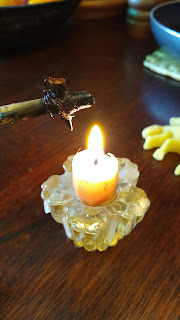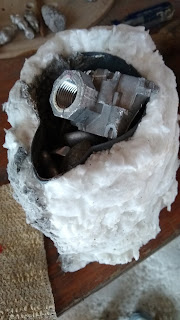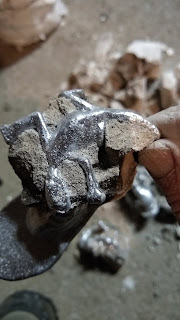Aluminum Salamanders
We're closing in now. I believe the end of the Age of Aluminum is in sight.
We started using this cool, albeit perhaps unnecessary, wax-dripper tool that people (like my sister-in-law) use for decorating Easter Eggs. It helped to glue the sprues and vents to the legs.
Here are all the patterns ready for molding.
There was a yoni-lingam, a pinecone and Mrs. Willendorf in there, too.
One of the molds had some cardboard fuzz on it from the box I used, reminding me a little of the great footnote about Gilgamesh/Enkidu in Silo's, Universal Root Myths: "The
fact that Enkidu is born covered with hair (“the hero was born with
his body covered with hair as thick as the barley of the fields”)
could refer to the visible presence of materials added to reduce
plasticity (cereal cuttings, straw, and so on), which were added to
the clay to prevent it from cracking..."
The second part of the wax burnout in the kiln is in large part an olfactory process. Because it smells so bad when the residual wax burns!
But you can't decide entirely with your nose, because after the burnt smell subsided I thought the molds were done, but no...
I gave them another spell at 450º C and then they came out very clean.
It only took a short time to melt the aluminum. We have so much aluminum! -- from the motor casings and scrap things we've collected here and there. It's great.
Here's a video my daughter filmed of the casting:
Only one salamander really worked, the rest were mutants of one kind of another.
And I still don't really understand why. They were all vented, but here you can see the metal just got stuck, even though there's a gap. And it's never the same leg that didn't work.
The YL turned out beautifully, though - a real surprise.
The cone mold lacks some detail, so it turned out as best it could. (The Venus didn't work at all.)
So, next up, a few more fully-vented salamanders, a vented-Venus, and I think we'll be done with aluminum.
(And now I don't want to get ahead of myself, but it's been really something, working with this funny metal, so many experiments and trials, and learning about the vagaries and new demands of higher-temp casting and mold-making. I'm very glad we've taken this little detour into aluminum, instead of going from pewter straight to bronze as generally happens in the Fire Craft.)


















Congratulations!!!! It was very exciting to follow your aluminum era through your posts, messages and photos :)
ReplyDeleteThank you Csef!
DeleteBeautiful website and to see your process Roberto!
ReplyDelete